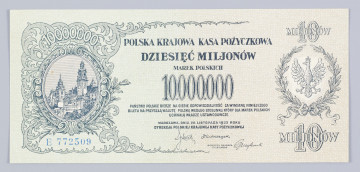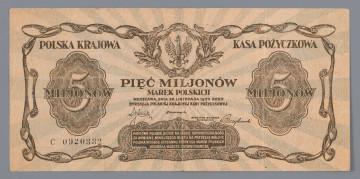
Cheque for 100,000,000 Polish marks - a template
1923
National Museum in Lublin
Part of the collection: Paper money during the Second Polish Republic
After World War I (1914-1918), European countries were affected by the economic and currency crisis. It affected to a much greater extent the defeated Germany, the Austro-Hungarian Empire, and Bolshevik Russia. Paper money was issued at that time without any gold cover, and the abolished convertibility of banknotes into bullion coins did not create an atmosphere of trust around them.
In October 1918, excluding local issues, Russia had 51 billion roubles in circulation, in 1920 - 147 billion, in 1921 - 4.5 trillion, in 1922 - 17 trillion, in early 1923 - nearly 2 quadrillion, at the beginning of 1924 - 23 quadrillion, and in March 1924, already 810 quadrillion roubles. It is worth knowing that the purchasing power of circulating money in Russia in March 1924 corresponded only to 0.6% of its real value before the outbreak of war.
The Swiss franc, valued in 1919 at 5-6 Austrian crowns, in July 1922 already cost 3600 crowns. In November 1922, the value of the Austrian currency settled at 0.015% of its pre-crisis value. By the end of 1922, prices in Germany were 1200 times higher than before the war. In the eight years since the outbreak of war, the price of the dollar had risen 1,600 times, wholesale prices 1,500 times, retail prices 700 times, wages 500 times, and the amount of money in circulation 600 times. Printing houses could not keep up with inflation.
Currency problems also affected the reborn Polish state, where until 1924 the role of a banking institution was played by the Polish National Loan Fund (PKKP), which issued Polish marks (mkp). Within two years, by December 1923, the amount of money in circulation had risen from 230 billion to 125 billion mkp, and prices had risen 2500-fold. Hyperinflation forced the printing of banknotes of ever higher values. An example of this is the denomination 100 000 mkp, introduced into circulation on 12 October 1923, designed and printed at the State Graphic Works in Warsaw, in typographic technique in brown, light orange and steel blue colours.
The purchasing power of this denomination on 12 October 1923 was relatively insignificant, since the evening edition of "Kurier Warszawski" cost 10,000 mkp, and its monthly subscription together with the morning supplement 200,000 mkp. By the end of 1923, this banknote was already the equivalent of the evening edition of that daily.
Tomasz Markiewicz
Author / creator
Dimensions
cały obiekt: height: 162 mm, width: 79 mm
Object type
paper money
Technique
Material
paper
Creation time / dating
Creation / finding place
Owner
The National Museum in Lublin
Identification number
Location / status

1923
National Museum in Lublin

1923
National Museum in Lublin

1923
National Museum in Lublin
DISCOVER this TOPIC
Castle Museum in Łańcut
DISCOVER this PATH
Educational path